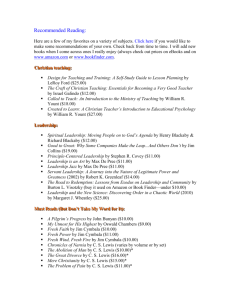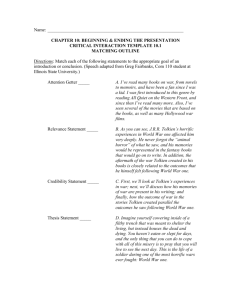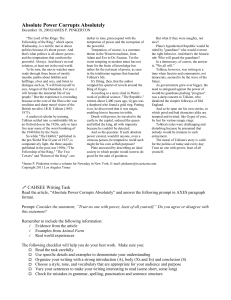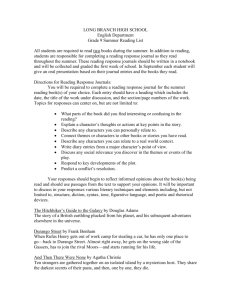Rags of Lordship - Taylor University
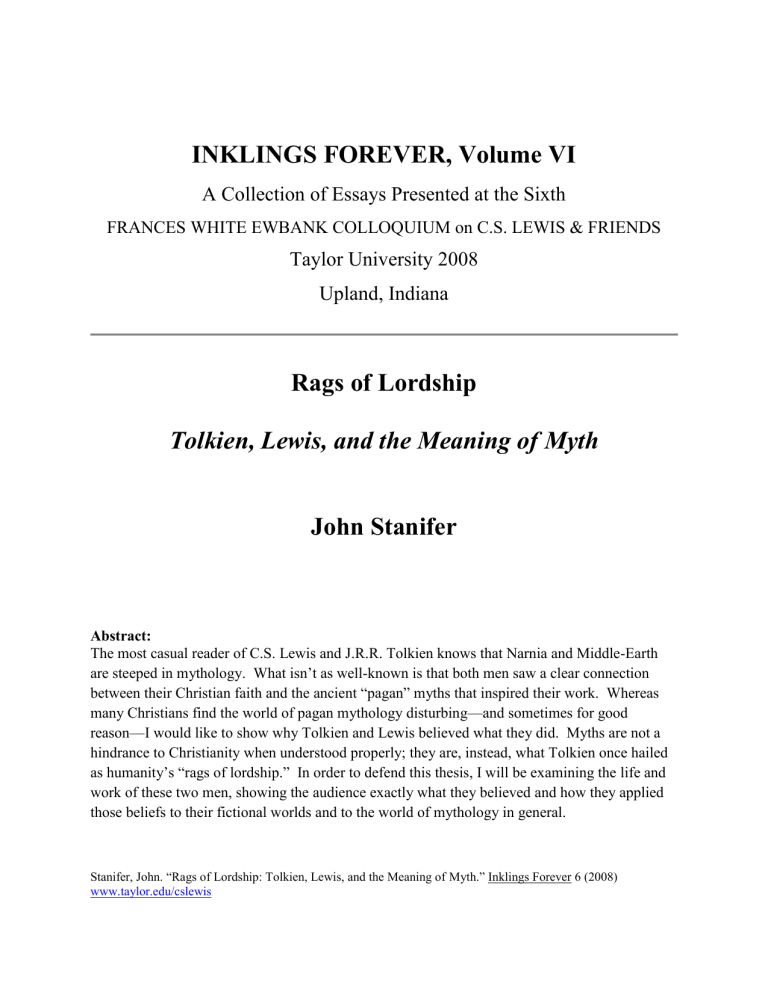
INKLINGS FOREVER, Volume VI
A Collection of Essays Presented at the Sixth
FRANCES WHITE EWBANK COLLOQUIUM on C.S. LEWIS & FRIENDS
Taylor University 2008
Upland, Indiana
Rags of Lordship
Tolkien, Lewis, and the Meaning of Myth
John Stanifer
Abstract:
The most casual reader of C.S. Lewis and J.R.R. Tolkien knows that Narnia and Middle-Earth are steeped in mythology. What isn‟t as well-known is that both men saw a clear connection between their Christian faith and the ancient “pagan” myths that inspired their work. Whereas many Christians find the world of pagan mythology disturbing—and sometimes for good reason—I would like to show why Tolkien and Lewis believed what they did. Myths are not a hindrance to Christianity when understood properly; they are, instead, what Tolkien once hailed as humanity‟s “rags of lordship.” In order to defend this thesis, I will be examining the life and work of these two men, showing the audience exactly what they believed and how they applied those beliefs to their fictional worlds and to the world of mythology in general.
Stanifer, John. “Rags of Lordship: Tolkien, Lewis, and the Meaning of Myth.” Inklings Forever 6 (2008) www.taylor.edu/cslewis
Rags of Lordship: Tolkien, Lewis, and the Meaning of Myth
We begin with a riddle: what do unicorns, centaurs , pagan deities of corn and wine, and
Jesus Christ have in common? While those unfamiliar with the views of C.S. Lewis and J.R.R.
Tolkien regarding mythology may be scratching their heads, the answer isn‟t as elusive or as blasphemous as it might seem. The most casual reader of these pipe-smoking Oxford academics knows that Narnia and Middle-Earth are steeped in mythology. What isn‟t as well known is that both men saw a clear connection between their Christian beliefs and the ancient pagan myths that inspired their work.
Some have found these pagan elements disturbing and even cause for rage. One selfstyled critic has said that Lewis‟ allusions to pagan mythology are “sick beyond description”
(Nattan)! While the majority of critics are hardly so forceful, I believe it is well worth trying to figure out why these two Christian men were so fascinated by these seemingly made-up stories, some of which are graphic and, at least on the surface, are far from edifying to the believer. By the time we are finished, I hope that my readers will understand where Lewis and Tolkien were coming from, because I believe, as they did, that myths are not a hindrance to the Christian faith when understood properly; they are, instead, what Tolkien once hailed as humanity‟s “rags of lordship.”
Our first step will be a look at one of the defining moments in C.S. Lewis‟ spiritual life.
On the evening of September 19, 1931, Lewis—better known as “Jack” to his friends—took a rambling stroll with Tolkien and Hugo Dyson, who was one of their regular friends from the
Inklings, the literary all-stars club that included Tolkien and Lewis. No doubt, in the course of this conversation—which lasted well past their bedtime—the friends covered a variety of topics, but what is most significant here is that Tolkien and Dyson, both devoted Christians at this point, shared their views on the relationship between faith and mythology with Lewis, who by this time had moved from atheism to theism. He believed that there was a God; he just wasn‟t quite ready to believe that Christ was who the Christians said he was (Duriez, 53-55).
Shortly after their nighttime jaunt on the twenty-first of September, Lewis writes that “I was driven to Whipsnade [Zoo]…When we set out I did not believe that Jesus Christ is the Son of God, and when we reached the zoo I did” ( Surprised by Joy , 237). Walter Hooper, one of
Lewis‟ most prolific biographers and historians, fixes the date of this apparent conversion as the twenty-eighth of September, just nine days after the conversation with Tolkien and Dyson
(Hooper, 972). While there were certainly a number of other factors that led to his transition from a mere theist into a mere Christian, it appears that this pivotal discussion with Dyson and
Gandalf—excuse me, Tolkien—may very well have pushed Lewis over the edge.
So what did these two men have to say to Lewis that was so compelling? To find out, we need only turn to a letter Lewis wrote to his friend, Arthur Greeves, a few weeks later. Here is what Lewis had to say:
Now what Dyson and Tolkien showed me was this: that if I met the idea of sacrifice in a
Pagan story I didn‟t mind it at all [that is, it didn‟t bother him the way a sermon on
Christianity might]; again, that if I met the idea of a god sacrificing himself…I liked it very much and was mysteriously moved by it: again, that the idea of the dying and reviving god (Balder, Adonis, Bacchus) similarly moved me provided I met it anywhere except in the Gospels. The reason was that in Pagan stories I was prepared to feel the
myth as profound and suggestive of meanings beyond my grasp even tho‟ I could not say in cold prose „what it meant‟.
Now the story of Christ is simply a true myth: a myth working on us in the same way as the others, but with this tremendous difference that it really happened: and one must be content to accept it in the same way, remembering that it is God‟s myth where the others are men‟s myths: i.e. the Pagan stories are God expressing Himself through the minds of poets, using such images as He found there, while Christianity is God expressing Himself through what we call „real things‟ [that is, real historical events].
(Hooper, 976-77)
So here is one of the most influential Christian apologists of the twentieth century stating, in no uncertain terms, that the pagan stories are “God expressing Himself through the minds of poets.” Of course, it‟s important that one understands what Lewis is and isn‟t saying about myth in this letter. Clearly, a myth isn‟t something that is necessarily untrue, since he states that the story of Christ is a “true myth.” Also, when we place Lewis‟ remarks in context with the rest of his work, we will see that he would not have wanted his readers to idolize the stories of pagan myth at the expense of the Christian narrative to which the earlier myths were, as he and his friend Tolkien believed, subordinate.
But first, before we examine Lewis‟ work, let‟s see how closely his memory of that fateful conversation with Dyson and Tolkien matched up with what Tolkien himself had to say about it. While Lewis was writing his letter to Arthur Greeves, Tolkien was “composing a long poem recording what he had said to Lewis” (Carpenter, 152). According to Tolkien biographer
Humphrey Carpenter, the poem, titled “Mythopoeia”—which means “the making of myths”—
“laid bare the centre of [Tolkien‟s] philosophy as a writer” expressing the “inherent truth of mythology” (151). By scrutinizing one of the more important passages, we can summarize the poem and, in effect, discover the spiritual core behind Middle-Earth and Narnia.
This is the passage in question:
The heart of man is not compound of lies, but draws some wisdom from the only Wise, and still recalls him. Though now long estranged, man is not wholly lost nor wholly changed.
Dis-graced he may be, yet is not dethroned, and keeps the rags of lordship once he owned, his world-dominion by creative act. (qtd. in Jacobs, 145)
To those who suggest that a myth is merely a “compound of lies,” Tolkien rebuts with the idea that man, fallen as he is through sin, still recalls the God of Abraham, Isaac, and Jacob, even if he has never seen a Bible. No matter how godless or “pagan” some of them may appear on the surface, man‟s stories—his attempts to make sense of the world around him—bear the imprint of his Maker. In a very real sense, when he engages in the “creative act” of telling a story, man is exercising the world-dominion of his Heavenly Father, only on a smaller scale and with limited tools; to use Tolkien‟s phrase, man is a “Sub-creator” (Carpenter and Tolkien, 145).
So, now that we have established what Tolkien and C.S. Lewis believed about the
Christian‟s relationship to pagan myth, how did those beliefs transfer to the fictional worlds of
Narnia and Middle-Earth? Though most fans of Lewis have made the connection between the
figure of Christ and the figure of Aslan, one of the more interesting passages from the Narnia books is, in my opinion, this one from Prince Caspian, book two (or book four, depending on how you look at it). It‟s not discussed as often as the scene of Aslan‟s death on the Stone Table in The Lion, the Witch, and the Wardrobe, and it comes at the end of one of those scenes that a learned critic might be tempted to call “sick beyond description”:
One saw sticky and stained fingers everywhere and, though mouths were full, the laughter never ceased nor the yodeling cries of Euan, euan, eu-oi-oi-oi-oi, till all of a sudden everyone felt at the same moment that the game (whatever it was), and the feast, ought to be over, and everyone flopped down breathless on the ground and turned their faces to Aslan to hear what he would say next.
At that moment the sun was just rising and Lucy remembered something and whispered to Susan,
“I say, Su, I know who they are.”
“Who?”
“The boy with the wild face is Bacchus and the old one on the donkey is Silenus.
Don‟t you remember Mr. Tumnus telling us about them long ago?”
“Yes, of course. But I say, Lu—”
“What?”
“I wouldn‟t have felt safe with Bacchus and all his wild girls if we‟d met them without Aslan.”
“I should think not,” said Lucy. (
Prince Caspian, 159-60)
There are two points I would like to make about this passage. The first—and probably the more crucial—is that Lewis seems to be issuing a warning. In a roundabout way, I believe he is asking his readers to be careful. Just as they can be a road to Christian faith (as they were for
Lewis), the pagan myths—when separated from their links to Aslan or Christ—can also prove dangerous. The second point, which is closely related to the first, is that in the presence of
Aslan, all the other figures of myth, including Bacchus, are given their proper place.
To the Romans, of course, the Bacchus mentioned in this passage was the god of wine, known as Dionysus to the Greeks. The poet Ovid describes him as “a little fellow as pretty as a girl, who seemed to stagger, heavy with sleep and wine” (Ovid, 76). No wonder Susan and Lucy feel unsafe with this character! It is obvious in these short excerpts from Lewis and Ovid that
Bacchus is a partygoer; after all, the “sticky and stained fingers” Susan and Lucy observe around them are a reminder that they and their fellow partygoers are wallowing in a sea of juicy grapes, thanks to the effect Bacchus‟ presence is having on the soil.
So how does one go about “redeeming” such a figure? We might start by recounting
Christ‟s first recorded miracle in the Gospel of John. Jesus is at a wedding with his disciples, and the wine runs out. Jesus commands the servants to fill some jars with water and take a cupful of the new substance to the master of the feast. The master of the feast, tasting wine instead of water, assumes that the bridegroom has been “hiding the good stuff” until his guests have already had their fill of the lesser wine ( ESV, John 2:1-11).
As usual, C.S. Lewis has insights that will help us see how this ties in with the question of Bacchus. The first excerpt is from God in the Dock: “Every year, from Noah‟s time till ours,
God turns water into wine. That, men fail to see...but…the miracle [at the wedding] has only half its effect if it only convinces us that Christ is God: it will have its full effect if whenever we
see a vineyard or drink a glass of wine we remember that here works He who sat at the wedding party in Cana” (29).
Whereas it is easy to become so used to thinking of the agricultural cycle as a “natural thing,” Lewis equates the growing of grapes and the fermenting of wine with the power of Christ displayed at Cana. It is, in its own right, a miracle. It would seem, then, that Bacchus‟ ability to form grapes out of the soil is also a miracle—not in the same historical sense that we see in the
Gospels, perhaps, but it is a miracle, nonetheless.
But there is an even deeper layer to this story. If Bacchus was, as mythologist James
Frazer suggested, the “personification of the vine” and also “a deity of agriculture and the corn,” then he becomes, symbolically, more than just a god of drunkenness (Frazer). As one of Lewis‟ characters put it: “Was there any age in any land when men did not know that corn and wine were the blood and body of a dying and yet living god” (
Pilgrim’s Regress,
171)? Elsewhere, we learn that Bacchus was “often persecuted by those who refused to accept his divinity” (Grant,
152). He was, after all, the son of Zeus, king of the gods, and Semele, a mortal woman (151).
Moreover, as Frazer informs us, he was “believed to have died a violent death, but to have been brought to life again…his sufferings, death, and resurrection were enacted in his sacred rites”
(Frazer).
Interestingly, the followers of Bacchus or Dionysus had a taste for flesh—specifically, the flesh of animals. They believed that “to devour part of an animal was to partake of the god himself, a true sacramental meal” (Stapleton, 69). By now, all of this should sound familiar to anyone acquainted with basic Christian doctrine. Granted, there are differences between the figure of Christ and the figure of Bacchus that should not be ignored; for example, Bacchus was not born of a virgin (Grant, 151), and it is not explicitly stated by any of the authors quoted above that Bacchus‟ death was an atonement for sins. Still, this is a curious string of parallels, one that would seem to justify Lewis‟ assertions about the connectedness between paganism and
Christianity.
But, now that we have dissected a scene from the Narnia books, what about Tolkien? We already know that he shared Lewis‟ beliefs about pagan mythology, but how did he demonstrate those beliefs in his own writing? It is worth pointing out: this is where the two friends parted ways. Tolkien, apparently, hated allegory; and he believed that the Narnia books were “too literally representative of Christian doctrine” (Duriez, 135).
However, those who have delved into Tolkien‟s universe know that it contains its share of allusions to Christian faith and tradition, starting with the account of Middle-Earth‟s creation in The Silmarillion.
Ilúvatar, also known as “the One,” has created a race of beings known as the
Ainur. Look at these excerpts from the book:
And it came to pass that Ilúvatar called together all the Ainur and declared to them a mighty theme, unfolding…things greater and more wonderful than he had yet revealed…then Ilúvatar said to them: „Of the theme that I have declared to you, I will now that ye make in harmony together a Great Music‟…then the voices of the
Ainur…began to fashion the theme of Ilúvatar to a great music…but now Ilúvatar sat and hearkened, and for a great while it seemed good to him, for in the music there were no flaws. But as the theme progressed, it came into the heart of Melkor to interweave matters of his own imagining that were not in accord with the theme of Ilúvatar; for he sought therein to increase the power and glory of the part assigned to himself. (Tolkien,
13-14)
Although passages of Scripture describing the fall of Satan or Lucifer are quite rare— some would say nonexistent, depending on how such passages are interpreted—Tolkien‟s tale does at least bear a resemblance to the traditional Christian “myth” of the fall of Satan. The book of Isaiah says this: “How you are fallen from heaven, O Day Star, son of Dawn! How you are cut down to the ground, you who laid the nations low! You said in your heart, „I will ascend to heaven; above the stars of God I will set my throne on high‟” (
ESV, 4:12-13). Perhaps even more than Scripture, Tolkien‟s account shares similarities with dramatized versions of the
Lucifer story, like Milton‟s
Paradise Lost.
Elsewhere in Tolkien‟s invented mythology, we learn of the rebellion of the
Númenóreans, a name for the race of men from which the
Lord of the Rings’ character Aragorn is descended (Carpenter and Tolkien, 160). In this story, the Númenóreans are said to “dwell within…sight of the easternmost „immortal‟ land, Eressëa” (154). However, although they‟re allowed to dwell within sight of it, “they must not set foot on „immortal‟ lands, and so become enamoured of an immortality…which their nature [cannot] in fact endure” (154-55).
But, like true sons of Adam and daughters of Eve, they eventually decide that they can‟t live with such a restriction. “And since we have mastered all seas,” they say, “why should we not go to [the realm forbidden us] and greet there our friends [the immortals]…why should we not go…and taste there, were it but for a day, the bliss of the Powers” (Tolkien, 309)? Because of this rebellion, the land of Númenor is overwhelmed by the sea, and men are no longer able to dwell in that Eden-like land (Carpenter and Tolkien, 156).
Unfortunately, there are many other fascinating details to this story that we do not have time to go into here. What we hope we have shown is that those who describe Tolkien‟s world of orcs, elves, dwarves, and magic rings as an attempt to lead us astray with a “dazzling display of the occult, witchcraft, and evil” (“Entertainment Media Analysis Report”) are missing the incredible depth of Tolkien‟s writing—and hence, his very Christian worldview, which, as we have already shown, attributed what is best in the myths of man to our longing for God.
Now, in order to sum up what I‟ve spent the last many pages trying to say, I‟d like to use an image from The Last Battle.
In the final pages of this final volume in Lewis‟ Chronicles of
Narnia, all the friends of the lion Aslan are streaming into the new Narnia, all their tears, sins, and sorrows having passed away in the death of Old Narnia. Jewel the unicorn, yet another representative of all those disgusting pagan myths, exclaims his joy with these words: “I have come home at last! This is my real country! I belong here. This is the land I have been looking for all my life, though I never knew it till now” ( The Last Battle, 196). Everything that is true, honorable, just, pure, lovely, commendable, and excellent ( ESV, Philippians 4:8) in all the history of myth finds its home at last in Aslan‟s country.
Though now long estranged, man is not wholly lost nor wholly changed.
Dis-graced he may be, yet is not dethroned, and keeps the rags of lordship one he owned… (qtd. in Jacobs, 145)
Instead of focusing on what is disgraceful about myth, let us focus on those stories and those elements of myth that reflect Biblical truth. The more we do that, the more evidence we‟ll see of how God can reveal Himself through even through the most bizarre stories imaginable, and the more we‟ll see the truth of the Apostle Paul‟s words to the men of Athens:
And he made from one man every nation of mankind to live on all the face of the earth…that they should seek God, in the hope that they might feel their way toward him and find him. Yet he is actually not far from each one of us, for „in him we live and move and have our being,‟ as even some of your own poets have said, „for we are indeed his offspring.‟” ( ESV, Acts 17:26-28, emphasis mine).
Works Cited
Carpenter, Humphrey. J.R.R. Tolkien: A Biography.
London: George Allen & Unwin, 1977;
Boston: Houghton Mifflin, 1977.
--- and Christopher Tolkien, eds. The Letters of J.R.R. Tolkien.
London: George Allen &
Unwin, 1981; Boston: Houghton Mifflin, 1981.
Duriez, Colin. Tolkien and C.S. Lewis: The Gift of Friendship.
Mahwah, NJ: HiddenSpring,
2003.
“Entertainment Media Analysis Report.”
ChildCare Action Project (CAP): Christian Analysis of
American Culture.
18 December 2001. Accessed 21 February 2008.
<http://www.capalert.com/capreports/lordofrings_fellowship.htm>
Frazer, James George. The Golden Bough.
New York: Macmillan, 1922; Bartleby.com, 2000.
Accessed 15 February 2008. <www.bartleby.com/196/>
Grant, Michael and John Hazel. Gods and Mortals in Classical Mythology.
Springfield,
Massachusetts: G&C Merriam Company, 1973.
The Holy Bible, English Standard Version (ESV).
Wheaton, IL: Crossway Bibles, 2001.
Hooper, Walter, ed. The Collected Letters of C.S. Lewis, Volume 1.
New York: HarperCollins,
2004.
Jacobs, Alan. The Narnian: The Life and Imagination of C.S. Lewis.
San Francisco, CA:
HarperSanFrancisco, 2005.
Lewis, C.S. God in the Dock: Essays on Theology and Ethics.
Grand Rapids: Eerdmans, 1970.
---. The Last Battle.
Norwalk, CT: The Easton Press, 1956.
---. The Pilgrim’s Regress.
Grand Rapids, MI: Eerdmans, 1958.
---. Prince Caspian.
Norwalk, CT: The Easton Press, 1951.
---. Surprised by Joy.
New York: Harcourt Brace & Company, 1955.
Nattan, Mary Van. “Further Into the Depths of Satan in C.S. Lewis‟ Chronicles of Narnia.”
Balaam’s Ass Speaks
. Date of posting unknown. Accessed 17 January 2008.
<http://www.balaams-ass.com/journal/homemake/lewsdion.htm>.
Ovid. Metamorphoses.
Trans. Rolfe Humphries. Bloomington, IN: Indiana University Press,
1955.
Stapleton, Michael. A Dictionary of Greek and Roman Mythology.
New York: Bell Publishing
Company, 1978.
Tolkien, J.R.R. The Silmarillion.
London: The Folio Society, 1997.
